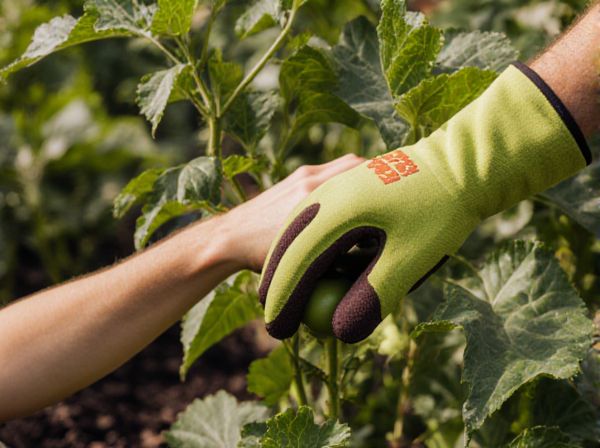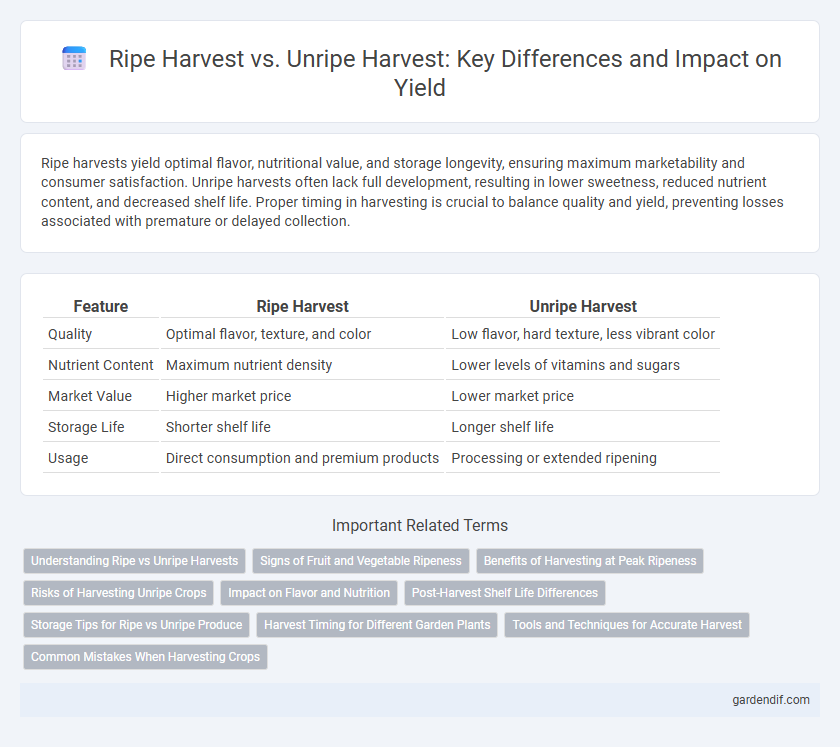
Ripe Harvest vs Unripe Harvest Illustration
Ripe harvests yield optimal flavor, nutritional value, and storage longevity, ensuring maximum marketability and consumer satisfaction. Unripe harvests often lack full development, resulting in lower sweetness, reduced nutrient content, and decreased shelf life. Proper timing in harvesting is crucial to balance quality and yield, preventing losses associated with premature or delayed collection.
Table of Comparison
| Feature | Ripe Harvest | Unripe Harvest |
|---|---|---|
| Quality | Optimal flavor, texture, and color | Low flavor, hard texture, less vibrant color |
| Nutrient Content | Maximum nutrient density | Lower levels of vitamins and sugars |
| Market Value | Higher market price | Lower market price |
| Storage Life | Shorter shelf life | Longer shelf life |
| Usage | Direct consumption and premium products | Processing or extended ripening |
Understanding Ripe vs Unripe Harvests
Ripe harvests contain fully developed fruits or crops with optimal nutrient content and flavor, ensuring maximum market value and shelf life. Unripe harvests often result in lower nutritional quality, reduced taste, and increased susceptibility to post-harvest losses. Timely identification of ripeness based on color, texture, and sugar levels is critical for optimizing yield and profitability in agricultural production.
Signs of Fruit and Vegetable Ripeness
Ripe harvests are characterized by vibrant color, firm but slightly yielding texture, and a strong, pleasant aroma indicating peak nutrient and sugar content. Unripe harvests often exhibit dull or green hues, hard texture, and lack the full fragrance, signaling insufficient development and lower flavor quality. Proper identification of these ripeness signs ensures optimal taste, texture, and nutritional value in fruits and vegetables.
Benefits of Harvesting at Peak Ripeness
Harvesting crops at peak ripeness ensures maximum nutritional value, optimal flavor, and higher market quality, making produce more appealing to consumers and increasing profitability. Ripe harvests reduce post-harvest losses due to better shelf life and resistance to decay compared to unripe harvests, which often require longer storage and processing. Timing the harvest accurately also enhances seed viability and ensures consistent yield quality for subsequent planting cycles.
Risks of Harvesting Unripe Crops
Harvesting unripe crops significantly reduces yield quality and market value due to incomplete nutrient development and lower sugar content. Unripe produce is more susceptible to post-harvest diseases and rapid spoilage, leading to increased economic losses and food waste. Premature harvest disrupts optimal crop maturation, negatively impacting flavor, texture, and overall consumer acceptance.
Impact on Flavor and Nutrition
Ripe harvest produces fruits and vegetables with optimal sugar, acid, and nutrient levels, enhancing flavor complexity and maximizing antioxidant content such as vitamins A and C. Unripe harvest often results in harsher, more astringent flavors due to higher tannin levels and reduced sweetness, while also containing lower amounts of essential phytonutrients. The timing of harvest significantly affects the nutritional profile, with ripe produce supporting better health benefits and culinary quality.
Post-Harvest Shelf Life Differences
Ripe harvest fruits exhibit a shorter post-harvest shelf life due to their higher respiration rates and increased enzymatic activity, leading to faster spoilage and softening. Unripe harvest fruits maintain firmer texture and lower respiration rates, extending shelf life and allowing for longer storage and transportation. Managing harvest timing is crucial to balance immediate flavor quality with post-harvest longevity in commercial distribution.
Storage Tips for Ripe vs Unripe Produce
Ripe harvest produce requires immediate cooling and storage in a controlled environment to slow down respiration and prevent spoilage, typically between 32degF to 40degF with high humidity. Unripe harvest fruits benefit from ripening at room temperature in a well-ventilated area before refrigeration to enhance flavor and texture development. Proper segregation of ripe and unripe produce during storage minimizes ethylene exposure, preserving quality and extending shelf life.
Harvest Timing for Different Garden Plants
Harvest timing significantly impacts the quality and flavor of garden plants, with ripe harvests providing the best nutritional value and taste. Fruits like tomatoes and peppers develop sugars and nutrients fully when allowed to ripen on the plant, whereas premature harvesting reduces their sweetness and texture. Leafy greens, such as spinach and lettuce, benefit from early harvesting to avoid bitterness, highlighting the necessity of plant-specific harvest timing.
Tools and Techniques for Accurate Harvest
Precise tools like moisture meters, refractometers, and handheld infrared sensors are essential for distinguishing ripe harvest from unripe harvest by accurately measuring sugar content, moisture levels, and fruit maturity. Techniques such as visual inspection, tactile assessment, and timed sampling enable farmers to optimize harvest timing and reduce post-harvest losses. Integrating digital platforms and GPS mapping further enhances accuracy by tracking harvest data and field variability in real time.
Common Mistakes When Harvesting Crops
Harvesting crops before they reach full ripeness often leads to reduced nutrient content and flavor, negatively impacting market value and consumer satisfaction. Common mistakes include misjudging color changes and texture, which are critical indicators of ripeness, causing premature or delayed harvesting. Proper understanding of crop-specific maturation signs ensures optimal yield quality and minimizes post-harvest losses.
Ripe Harvest vs Unripe Harvest Infographic

 gardendif.com
gardendif.com